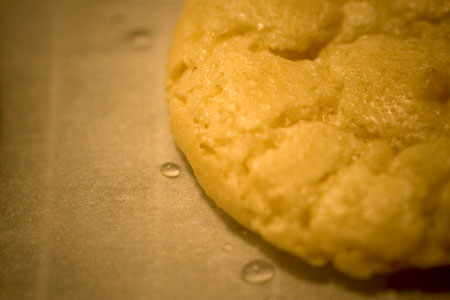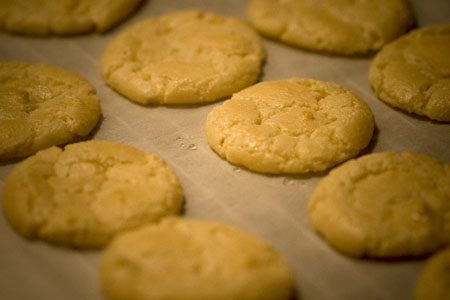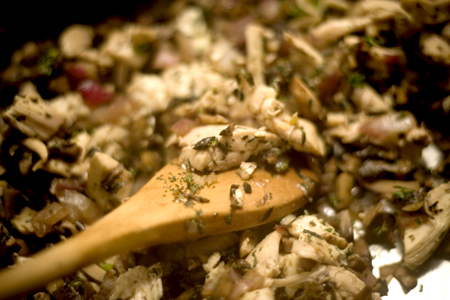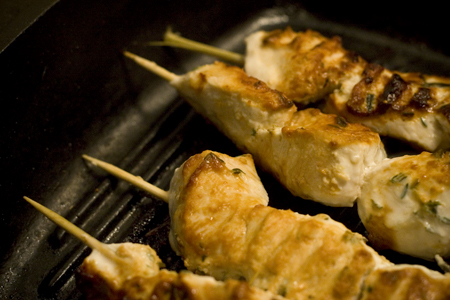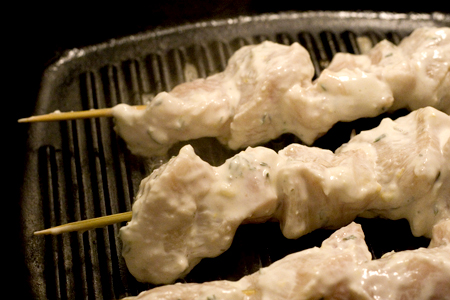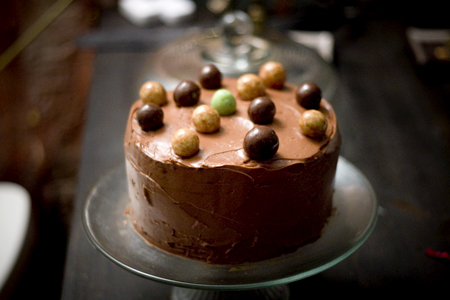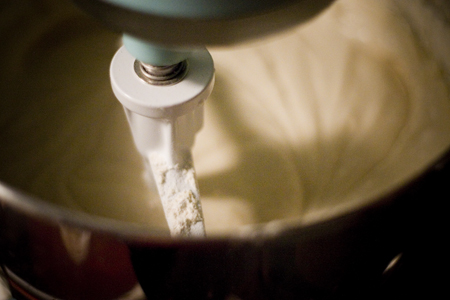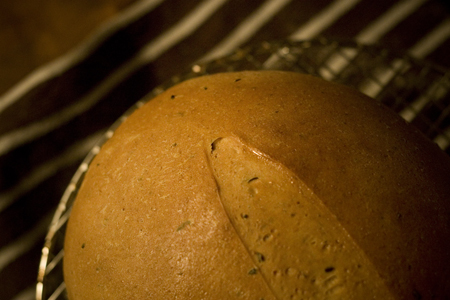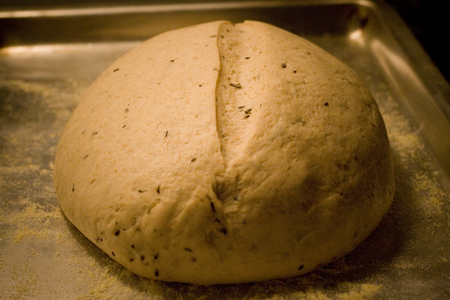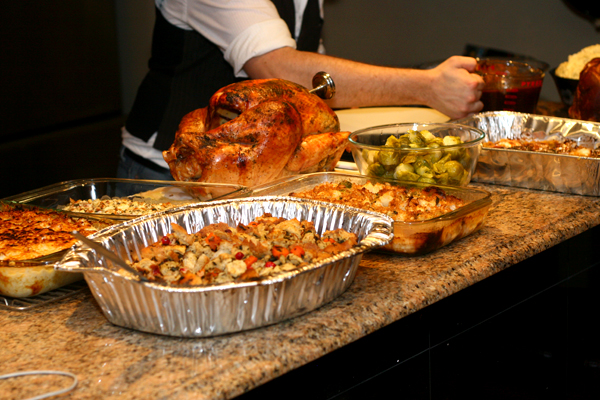
This is it.
This is the best recipe I have to offer in 2008, my vote for tastiest homemade entree we've had this year. (That goat cheese
cheesecake was pretty darn awesome, too, but it's not exactly a balanced meal on its own.)
Cioppino is a tomatoey fish stew with a touch a fennel and saffron, green peppers and deep red wine. Traditionally, a fish stock was brewed with the heads and bones from the catch of the day, and fish cubes and clams, fresh shrimp, or other shellfish are added at the last minute. With each spoonful, I could picture the Portuguese or Italian fishermen who first cooked this onboard their ships along the coast of California. Perfect for a drizzly, cold day at sea (or on land), cioppino is meaty and warming, somehow both delicate and bold.
We used to make a seafood caesar salad every year on Christmas Eve, taking advantage of the Dungeness crab season. But you don't really feel like something cold that night, especially when the weather is grim, so several years ago my mom switched to cioppino for this occasion. Her recipe has evolved over the years, and it seems to be constantly improving.

I urge you to make this dish as soon as you can get your hands on some nice seafood—maybe for New Years? Feel free to play around with the fish a little depending on what's fresh—I imagine scallops could be added, or you could use grouper instead of halibut. This year we used salmon and red snapper, little manila clams and fresh, sweet shrimp. Cioppino is great dinner party food—totally impressive but you can easily prepare the soup base a day ahead, and just plop the seafood in when your guests arrive. Don't skip the garlicky aioli (sort of fake-oli since you start with a jar of mayo). The punch of garlic and creaminess stirred into the soup is essential.
Please don't fear the long recipe—it's really not a tricky one.
Mom's Christmas Eve Cioppino (Adapted from from The New York Times Cookbook & other recipes)
10 servings4 T olive oil
3 cups chopped onion
1 leek, trimmed, washed well, & finely chopped
2 to 4 cloves garlic, finely chopped
1 green, yellow, or orange bell pepper, cored, seeded, cut into thin strips
1 Yukon Gold or other small potato, halved and sliced, optional
2 sticks celery or one small fennel bulb, sliced, optional
4 cups chopped imported peeled tomatoes (canned, diced)
1 cup fresh or canned tomato sauce
1 small can tomato juice
salt, freshly ground black pepper
1 bay leaf
1/2 tsp dried oregano
1/2 tsp dried thyme
1 tsp dried basil
red pepper flakes
1/4 tsp saffron (or up to 1 tsp.)
1/2 tsp grated orange zest or 2 strips of orange peel
juice from one orange
2 cups chicken broth if making soup base ahead, or fish stock if finishing in the same day
1 cup water or broth
1 cup red zinfandel or white wine—use something decent!
1-1/2 to 2 lb. firm-fleshed fish such as striped bass, sea bass, halibut, or salmon cut into 2-in. pieces (2-1/2 lbs. for bone-in steaks, bones to be used for fish stock)
1 lb. raw shrimp shelled & deveined (wild fresh rock shrimp were superb)
2 doz. well washed small clams in shell
1/2 lb crabmeat or 1 hard shell crab, cooked in shell & cracked
1 qt chicken or fish broth to add as needed for desired consistency
optional seafood additions1/2 lb bay scallops
1/4 cup shucked oysters in their liquor
1/2 lb lobster tail cooked in shell
Fish stock for approximately 4 to 6 cups Buy bone-in fish steaks for the soup. Cut the meat into 2-in. pieces and refrigerate, putting all the bones and skin in a pot with an onion studded with 2 cloves, a carrot and celery stick (or fennel bulb trimmings) cut in pieces, bay leaf, and peppercorns to taste, and cook in water to cover (approx. 4 to 6 cups) for 2 hours.
AoliMash 2 cloves garlic, chopped; add 1 cup mayo & squeeze of lemon juice.
Grilled CroutonsThinly slice enough of a baguette on the diagonal for 2 pieces per person. Lightly brush each piece with olive oil and bake in 350° oven til crisp.
1. Cook onion & leek in olive oil, stirring often, until just lightly browned. Add garlic, green pepper, and celery or fennel if used & cook til they wilt. Add potato, if used, tomatoes, tomato sauce and juice, salt & pepper to taste, bay leaf, oregano, thyme, basil, saffron, and 1/4 tsp red pepper flakes. Add chicken broth (or fish stock if serving the same day) and orange zest or strips and juice & cook slowly for about 2 hrs, stirring often to prevent burning. More chicken or fish stock may be added if desired.
2. Add broth & wine and cook 10 minutes more. Soup may be made in advance to this point, or, if using fish stock, do this step 30 minutes before serving, just before step 3.
3. Twenty minutes or so before serving, return soup to the boil and add fish pieces (you will be adding seafood in order of how long it needs to cook—don't overcook!) Cook about 4 minutes and add scallops if used. Cook 3 minutes, stirring gently. Add clams, shrimp and other shellfish. If using fresh crabmeat instead of a whole crab, put it directly in individual soup bowls just before serving so that it doesn’t get lost.
4. Cook stirring gently about 5 minutes or until clams open. Serve in very hot soup bowls with a grilled crouton on each bowl, and aoli and red pepper flakes on the side. Stir aoli into each serving at the table.
Soup base can be made ahead and frozen; add fish stock, fish, and seafood after thawing.
